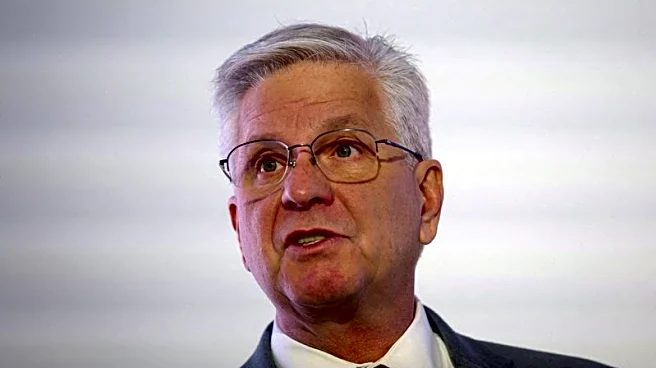What's Happening?
Ethereum's price volatility in 2025 has been closely linked to Federal Reserve policy signals, creating a dynamic interplay between macroeconomic uncertainty and on-chain resilience. The August FOMC meeting minutes highlighted inflation risks and the potential impact of Trump-era tariffs, initially causing a sell-off that pushed Ethereum into bearish territory. However, a subsequent dovish pivot by Fed Chair Jerome Powell at Jackson Hole, suggesting possible rate cuts depending on economic conditions, led to a 12% rebound, driving Ethereum to a new all-time high of $4,885. This fluctuation underscores the crypto market's sensitivity to central bank messaging, while Ethereum's fundamentals reveal structural strength. Daily transaction volumes have surged 43.83% year-over-year, driven by Layer 2 solutions like Arbitrum and zkSync, which now handle 60% of the network's volume. Gas fees have significantly decreased, enhancing Ethereum's utility-driven infrastructure.
Why It's Important?
The Federal Reserve's policy signals have created a volatile backdrop for Ethereum, yet the cryptocurrency's price action suggests that market participants are increasingly viewing rate cuts as likely. This has led to significant ETF inflows and staking demand, amplifying bullish sentiment. Ethereum spot ETFs attracted $27.6 billion in inflows by August 2025, outpacing Bitcoin's $548 million, highlighting Ethereum's role as a proxy for macroeconomic optimism. The network's on-chain resilience, characterized by increased transaction volumes and reduced gas fees, positions Ethereum as a critical infrastructure layer for both digital and traditional capital markets. The SEC's reclassification of Ethereum as a utility token has further accelerated institutional adoption, with Ethereum ETFs holding substantial assets under management.
What's Next?
The ongoing volatility driven by FOMC policy signals will continue to impact Ethereum's short-term price movements. However, the network's fundamentals, supported by institutional adoption, technological upgrades, and yield generation, suggest a compelling long-term investment case. Investors will need to balance macro-driven caution with recognition of Ethereum's evolving role as a utility asset. The probability of a September rate cut has climbed to 87%, creating a tailwind for Ethereum as a high-yield, high-volatility asset. This environment may lead to further strategic positioning by investors, as evidenced by the movement of ETH into staking protocols during recent price corrections.
Beyond the Headlines
Ethereum's institutional appeal is underscored by whale activity and corporate treasury strategies, with significant ETH accumulation and staking as a yield-generating reserve asset. The network's dominance in DeFi and smart contract innovation further solidifies its position as a critical infrastructure layer. Despite bearish indicators like a 15% MVRV ratio, Ethereum's structural advantages, including regulatory clarity and technological upgrades, provide a foundation for long-term growth. The network's resilience amid macroeconomic headwinds suggests a strategic buying opportunity for investors willing to navigate the volatility.













